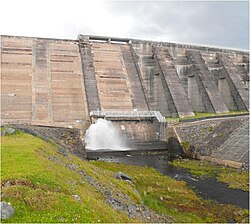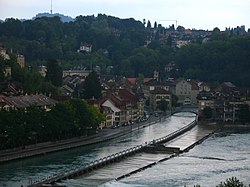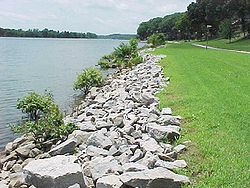Hydraulic engineering



Hydraulic engineering as a sub-discipline of civil engineering is concerned with the flow and conveyance of fluids, principally water and sewage. One feature of these systems is the extensive use of gravity as the motive force to cause the movement of the fluids. This area of civil engineering is intimately related to the design of bridges, dams, channels, canals, and levees, and to both sanitary and environmental engineering.
Hydraulic engineering is the application of the principles of fluid mechanics to problems dealing with the collection, storage, control, transport, regulation, measurement, and use of water.
Fundamental principles
A few examples of the fundamental principles of hydraulic engineering include fluid mechanics, fluid flow, behavior of real fluids, hydrology, pipelines, open channel hydraulics, mechanics of sediment transport, physical modeling, hydraulic machines, and drainage hydraulics.
Fluid mechanics
Fundamentals of Hydraulic Engineering defines hydrostatics as the study of fluids at rest.[1] In a fluid at rest, there exists a force, known as pressure, that acts upon the fluid's surroundings. This pressure, measured in N/m2, is not constant throughout the body of fluid. Pressure, p, in a given body of fluid, increases with an increase in depth. Where the upward force on a body acts on the base and can be found by the equation:
where,
- ρ = density of water
- g = specific gravity
- y = depth of the body of liquid
Rearranging this equation gives you the pressure head . Four basic devices for
As Prasuhn states:
- On undisturbed submerged bodies, pressure acts along all surfaces of a body in a liquid, causing equal perpendicular forces in the body to act against the pressure of the liquid. This reaction is known as equilibrium. More advanced applications of pressure are that on plane surfaces, curved surfaces, dams, and quadrant gates, just to name a few.[1]
Behavior of real fluids
Real and Ideal fluids
The main difference between an ideal fluid and a real fluid is that for ideal flow p1 = p2 and for real flow p1 > p2. Ideal fluid is incompressible and has no viscosity. Real fluid has viscosity. Ideal fluid is only an imaginary fluid as all fluids that exist have some viscosity.
Viscous flow
A viscous fluid will deform continuously under a shear force by the pascles law, whereas an ideal fluid does not deform.
Laminar flow and turbulence
The various effects of disturbance on a viscous flow are a stable, transition and unstable.
Bernoulli's equation
For an ideal fluid,
As the flow comes into contact with the plate, the layer of fluid actually "adheres" to a solid surface. There is then a considerable shearing action between the layer of fluid on the plate surface and the second layer of fluid. The second layer is therefore forced to decelerate (though it is not quite brought to rest), creating a shearing action with the third layer of fluid, and so on. As the fluid passes further along with the plate, the zone in which shearing action occurs tends to spread further outwards. This zone is known as the "boundary layer". The flow outside the boundary layer is free of shear and viscous-related forces so it is assumed to act as an ideal fluid. The intermolecular cohesive forces in a fluid are not great enough to hold fluid together. Hence a fluid will flow under the action of the slightest stress and flow will continue as long as the stress is present.[3] The flow inside the layer can be either vicious or turbulent, depending on Reynolds number.[1]
Applications
Common topics of design for hydraulic engineers include hydraulic structures such as
Related branches include hydrology and rheology while related applications include hydraulic modeling, flood mapping, catchment flood management plans, shoreline management plans, estuarine strategies, coastal protection, and flood alleviation.
History
Antiquity
Earliest uses of hydraulic engineering were to irrigate crops and dates back to the Middle East and Africa. Controlling the movement and supply of water for growing food has been used for many thousands of years. One of the earliest hydraulic machines, the water clock was used in the early 2nd millennium BC.[4] Other early examples of using gravity to move water include the Qanat system in ancient Persia and the very similar Turpan water system in ancient China as well as irrigation canals in Peru.[5]
In ancient China, hydraulic engineering was highly developed, and engineers constructed massive canals with levees and dams to channel the flow of water for irrigation, as well as locks to allow ships to pass through. Sunshu Ao is considered the first Chinese hydraulic engineer. Another important Hydraulic Engineer in China, Ximen Bao was credited of starting the practice of large scale canal irrigation during the Warring States period (481 BC–221 BC), even today hydraulic engineers remain a respectable position in China.

In the
Eupalinos of Megara was an ancient Greek engineer who built the Tunnel of Eupalinos on Samos in the 6th century BC, an important feat of both civil and hydraulic engineering. The civil engineering aspect of this tunnel was that it was dug from both ends which required the diggers to maintain an accurate path so that the two tunnels met and that the entire effort maintained a sufficient slope to allow the water to flow.
Hydraulic engineering was highly developed in Europe under the aegis of the
In the 15th century, the
Further advances in hydraulic engineering occurred in the
Modern times
In many respects, the fundamentals of hydraulic engineering have not changed since ancient times. Liquids are still moved for the most part by gravity through systems of canals and aqueducts, though the supply reservoirs may now be filled using pumps. The need for water has steadily increased from ancient times and the role of the hydraulic engineer is a critical one in supplying it. For example, without the efforts of people like William Mulholland the Los Angeles area would not have been able to grow as it has because it simply does not have enough local water to support its population. The same is true for many of our world's largest cities. In much the same way, the central valley of California could not have become such an important agricultural region without effective water management and distribution for irrigation. In a somewhat parallel way to what happened in California, the creation of the Tennessee Valley Authority (TVA) brought work and prosperity to the South by building dams to generate cheap electricity and control flooding in the region, making rivers navigable and generally modernizing life in the region.
Leonardo da Vinci (1452–1519) performed experiments, investigated and speculated on waves and jets, eddies and streamlining. Isaac Newton (1642–1727) by formulating the laws of motion and his law of viscosity, in addition to developing the calculus, paved the way for many great developments in fluid mechanics. Using Newton's laws of motion, numerous 18th-century mathematicians solved many frictionless (zero-viscosity) flow problems. However, most flows are dominated by viscous effects, so engineers of the 17th and 18th centuries found the inviscid flow solutions unsuitable, and by experimentation they developed empirical equations, thus establishing the science of hydraulics.[3]
Late in the 19th century, the importance of dimensionless numbers and their relationship to turbulence was recognized, and dimensional analysis was born. In 1904 Ludwig Prandtl published a key paper, proposing that the flow fields of low-viscosity fluids be divided into two zones, namely a thin, viscosity-dominated boundary layer near solid surfaces, and an effectively inviscid outer zone away from the boundaries. This concept explained many former paradoxes and enabled subsequent engineers to analyze far more complex flows. However, we still have no complete theory for the nature of turbulence, and so modern fluid mechanics continues to be combination of experimental results and theory.[21]
The modern hydraulic engineer uses the same kinds of
See also
- Civil engineering – Engineering discipline focused on physical infrastructure
- Civil engineering software – Software used in civil engineering
- Eupalinos – ancient Greek architect
- HEC-RAS – Software for simulating water flow within rivers
- Henri Pitot – French hydraulic engineer (1695–1771)
- Hydrology – Science of the movement, distribution, and quality of water on Earth and other planets
- Hydrology (agriculture)– study of water balance components intervening in agricultural water management, especially in irrigation and drainage
- Hydraulic jack– Mechanical lifting device
- Hydraulic mining – Mining technique using high-pressure water jets to carve away minerals
- Hydraulic structure – artificial structure which disrupts the natural flow of water
- International Association for Hydro-Environment Engineering and Research
- Irrigation – Agricultural artificial application of water to land
- Significant modern floods– Water overflow submerging usually-dry land
- Naval engineering – Engineering discipline dealing with the design and construction of marine vessels
- Sunshu Ao – Chinese hydraulic engineer and politician
- Ximen Bao – 4th-century BC Chinese philosopher and engineer
References
- ^ a b c d e f Prasuhn, Alan L. Fundamentals of Hydraulic Engineering. Holt, Rinehart, and Winston: New York, 1987.
- ^ Cassidy, John J., Chaudhry, M. Hanif, and Roberson, John A. "Hydraulic Engineering", John Wiley & Sons, 1998
- ^ a b c E. John Finnemore, Joseph Franzini "Fluid Mechanics with Engineering Applications", McGraw-Hill, 2002
- ^ "Clepsydra". Encyclopedia Britannica.
- ^ "Qanats" Water History. From 2001, ongoing. http://www.waterhistory.org/histories/qanats/
- ^ "Archived copy". www.geocities.com. Archived from the original on 1 December 2007. Retrieved 11 January 2022.
{{cite web}}: CS1 maint: archived copy as title (link) - ^ Filipinasoul.com.‘The Best’ of the Philippines – its natural wonders Archived 2014-11-05 at the Wayback Machine
- ^ National Statistical Coordinating Body of the Philippines. Facts & Figures: Ifugao Province Archived 2012-11-13 at the Wayback Machine
- ^ About Banaue > Tourist Attractions Archived 2008-12-14 at the Wayback Machine
- ^ Department of Tourism: Ifugao Province Archived 2009-03-02 at the Wayback Machine. Accessed September 04, 2008.
- ISBN 978-0313378577. Retrieved 2014-02-14.
- S2CID 143484233
- ^ S2CID 143484233
- ^ Ahmad Y Hassan, Flywheel Effect for a Saqiya Archived 2010-10-07 at the Wayback Machine.
- ^ Donald Routledge Hill, "Mechanical Engineering in the Medieval Near East", Scientific American, May 1991, pp. 64–69. (cf. Donald Routledge Hill, Mechanical Engineering Archived 2007-12-25 at the Wayback Machine)
- Ahmad Y Hassan. "The Origin of the Suction Pump: Al-Jazari 1206 A.D." Archived from the originalon 2008-02-26. Retrieved 2008-07-16.
- ^ Donald Routledge Hill (1996), A History of Engineering in Classical and Medieval Times, Routledge, pp. 143 & 150–152
- ISBN 978-1-4358-5066-8
- Ahmad Y Hassan, The Crank-Connecting Rod System in a Continuously Rotating Machine Archived 2013-03-12 at the Wayback Machine.
- ISBN 0-292-78149-0
- ^ Fluid Mechanics
Further reading
- Vincent J. Zipparro, Hans Hasen (Eds), Davis' Handbook of Applied Hydraulics, ISBN 0070730024, at Amazon.com
- Classification of Organics in Secondary Effluents. M. Rebhun, J. Manka. Environmental Science and Technology, 5, pp. 606–610, (1971). 25.
External links
- International Association of Hydraulic Engineering and Research
- Hydraulic Engineering in Prehistoric Mexico Archived 2015-04-30 at the Wayback Machine
- Hydrologic Engineering Center Archived 2013-03-08 at the Wayback Machine
- Chanson, H. (2007). Hydraulic Engineering in the 21st Century : Where to ?, Journal of Hydraulic Research, IAHR, Vol. 45, No. 3, pp. 291–301 (ISSN 0022-1686).




